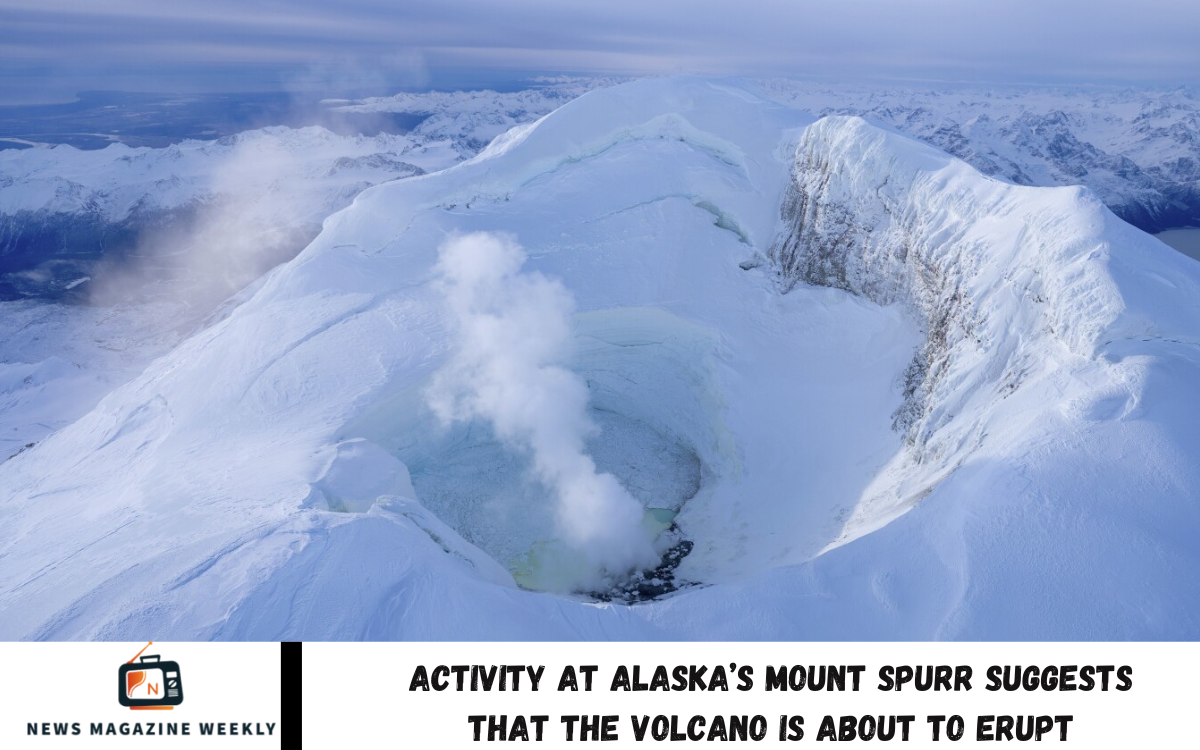Alaska’s Mount Spurr, a stratovolcano located about 130 kilometers (80 miles) west of Anchorage, is showing signs of potential eruption. Recent seismic activity, including increased earthquake frequency and ground deformation, has raised concerns among volcanologists. The AVO has reported heightened unrest, with tremors indicating magma movement beneath the surface.
Mount Spurr last erupted in 1992, spewing ash that disrupted air travel and covered Anchorage in volcanic dust. Scientists are closely monitoring gas emissions, temperature fluctuations, and other warning signs to assess the risk of another eruption. If Mount Spurr erupts, it could impact air traffic, wildlife, and nearby communities.
Authorities are urging residents and airlines to stay alert, as volcanic ash can damage aircraft engines and pose health risks. The AVO has increased monitoring efforts, using satellite imagery and seismic sensors to track changes in the volcano’s behavior. While an eruption is not yet inevitable, the growing signs of unrest suggest that Mount Spurr could soon awaken.
What is Mount Spurr?
Mount Spurr is an active stratovolcano in the Aleutian volcanic arc, approximately 130 kilometers (80 miles) west of Anchorage, Alaska. It is the highest volcano in the Aleutian Range and stands at an elevation of about 3,374 meters (11,070 feet).
The volcano is part of the Ring of Fire, a seismically active zone surrounding the Pacific Ocean, known for frequent earthquakes and volcanic eruptions. Mount Spurr consists of a central peak and a nearby satellite vent, Crater Peak, which has been the source of past eruptions.
History of Eruptions
Mount Spurr has erupted multiple times in history, with the most significant recent eruption occurring in 1992. This event sent ash clouds across Alaska, disrupting air travel and covering Anchorage in volcanic dust.
Due to its location near major air routes and populated areas, Mount Spurr is closely monitored by the AVO for signs of potential eruptions. Current volcanic activity has raised concerns that the volcano may erupt again, prompting scientists and officials to stay on high alert.
Why is Mount Spurr Showing Signs of Eruption?
Mount Spurr is exhibiting increased volcanic activity, suggesting that an eruption may be imminent. Scientists from the AVO have reported several warning signs that indicate magma movement beneath the surface.
Key Signs of Possible Eruption:
- Increased Seismic ActivityA rise in the frequency and intensity of earthquakes near Mount Spurr suggests magma is pushing upward.
- Swarms of small tremors are often a precursor to eruptions.
- Ground DeformationSatellite and GPS data show changes in the shape of the volcano, which could mean magma is accumulating beneath the surface.
- Gas EmissionsHigher levels of sulfur dioxide (SO₂) and carbon dioxide (CO₂) are being detected, indicating rising magma is releasing gases.
- Rising TemperaturesThermal imaging has detected hot spots in and around the crater, possibly due to increased volcanic heat.
- Changes in Water Bodies Nearby lakes and rivers may show warming or changes in water chemistry due to volcanic gases and heat.
What This Means
While these signs do not guarantee an eruption, they strongly suggest that Mount Spurr is becoming more active. Experts are closely monitoring the situation to assess the potential risk and issue warnings if necessary.
History of Mount Spurr’s Eruptions
Mount Spurr is an active stratovolcano in Alaska that has erupted multiple times throughout history. It is part of the Aleutian volcanic arc and is closely monitored due to its potential impact on air travel and nearby communities.
Significant Eruptions of Mount Spurr
- Roughly 10,000 Years AgoGeological evidence suggests that Mount Spurr has been active for thousands of years, with significant eruptions shaping its landscape.
- Late 19th to Early 20th Century (Unconfirmed Activity)There are historical accounts of possible eruptions or steam emissions, but no significant documented eruptions occurred during this time.
- 1953 EruptionThe first well-documented eruption of Mount Spurr occurred in July 1953.
- It produced ashfall that spread across parts of Alaska, but its impact was relatively minor compared to later eruptions.
- 1992 Eruption (Most Recent Major Eruption)The most significant eruption in recent history occurred in June, August, and September 1992 from Crater Peak, a vent on Mount Spurr’s southern flank.
- This eruption sent massive ash clouds into the atmosphere, disrupting air travel and covering Anchorage with volcanic ash.
- Some flights were canceled due to the danger volcanic ash poses to aircraft engines.
- The eruption also led to extensive monitoring and research on Alaskan volcanoes.
Current Status
Since the 1992 eruption, Mount Spurr has remained dormant, but recent seismic activity and ground deformation suggest that it may be reawakening. Scientists are closely watching the volcano for any signs of an imminent eruption.
Read Also: 20 of the Most Adorable Animals To Help Make Anyone’s Day
Current Volcanic Activity and Warnings
Mount Spurr is currently exhibiting signs of increased volcanic activity, raising concerns about a possible eruption. The Alaska Volcano Observatory (AVO) has detected multiple indicators that suggest magma movement beneath the surface.
Recent Volcanic Activity
- Seismic Activity: Increased earthquake swarms have been recorded beneath Mount Spurr, a strong indicator of rising magma.
- Some tremors have been shallow, meaning magma could be approaching the surface.
- Ground DeformationSatellite and GPS data show that the ground around the volcano is uplifting and expanding, suggesting magma buildup.
- Gas EmissionsHigher concentrations of sulfur dioxide (SO₂) and carbon dioxide (CO₂) have been detected, both of which are released when magma nears the surface.
- Thermal Activity Heat signatures from the crater area have increased, possibly indicating magma movement or changes in the volcanic vent system.
Warnings Issued by Authorities
- AVO Alert Level Raised: The volcano’s alert level has been upgraded from Normal to Advisory or Watch, depending on the intensity of the activity.
- Aviation Code Update: Due to the risk of ash clouds, the aviation color code may have been raised from Green (Normal) to Yellow (Advisory) or Orange (Watch).
- Precautionary Measures: Authorities are advising residents and travelers to be prepared for possible ashfall, especially in Anchorage and surrounding areas.
What’s Next?
Scientists are continuously monitoring Mount Spurr to determine if the activity will lead to an eruption. While an eruption is not yet inevitable, the increasing signs of unrest suggest the volcano could awaken soon. Residents, travelers, and airlines should stay informed through official updates from the AVO and local emergency management agencies.
How Scientists Are Monitoring Mount Spurr
Scientists from the Alaska Volcano Observatory (AVO) are closely monitoring Mount Spurr using advanced technology and field observations. By tracking key indicators of volcanic activity, they can assess the likelihood of an eruption and provide early warnings.
Key Monitoring Methods
- Seismometers (Earthquake Monitoring)AVO has placed seismic sensors around Mount Spurr to detect earthquakes and tremors caused by rising magma.
- An increase in the frequency and intensity of these quakes can indicate magma movement beneath the volcano.
- Satellite Imaging & Thermal CamerasInfrared satellites detect temperature changes in and around the volcano’s crater.
- Thermal imaging helps identify magma buildup and changes in volcanic vents.
- Ground Deformation Monitoring (GPS & Radar Interferometry)GPS stations track small shifts in the volcano’s surface, which can indicate magma rising.
- InSAR (Interferometric Synthetic Aperture Radar) satellites measure ground swelling or deformation.
- Gas Emission Analysis Scientists measure the amount of sulfur dioxide (SO₂), carbon dioxide (CO₂), and water vapor released from the volcano.
- A significant increase in these gases suggests magma is getting closer to the surface.
- Aviation and Ash Cloud Monitoring Scientists use weather radars, satellite images, and pilot reports to track ash clouds in case of an eruption.
- This helps warn airlines and prevent aircraft from flying into dangerous volcanic ash.
What Happens If an Eruption is Imminent?
If monitoring data shows a high risk of eruption, the AVO will issue warnings to local authorities, residents, and airlines. Alert levels and aviation color codes are updated in real-time to help people take precautions.
Scientists continue to monitor Mount Spurr 24/7, ensuring that any significant changes are detected early, giving communities time to prepare for a possible eruption.
Frequently Asked Questions
What impact could an eruption have on air travel?
Volcanic ash can damage aircraft engines, making flights extremely dangerous. The aviation color code for Mount Spurr is updated regularly to warn pilots and airlines.
Has Mount Spurr erupted before 1992?
Yes, a significant eruption was recorded in 1953, and geological evidence suggests eruptions occurred thousands of years ago.
What should residents near Mount Spurr do to prepare?
Authorities advise having emergency supplies, wearing masks during ashfall, staying indoors, and following updates from AVO and local officials.
Can you predict precisely when Mount Spurr will erupt?
While scientists can detect warning signs, predicting the exact time and size of an eruption is difficult. Continuous monitoring helps provide early warnings.
Where can people get official updates on Mount Spurr’s activity?
Official updates are provided by the Alaska Volcano Observatory (AVO), the U.S. USGS, and local emergency management agencies. Their websites and social media pages offer real-time information.
Conclusion
The recent increase in seismic activity, ground deformation, rising gas emissions, and thermal changes at Mount Spurr strongly suggests that the volcano could be reawakening. While an eruption is not yet inevitable, these warning signs indicate that magma is moving beneath the surface, making it essential to stay alert. The Alaska Volcano Observatory (AVO) is continuously monitoring the volcano using advanced technology to detect any further escalation in activity.

